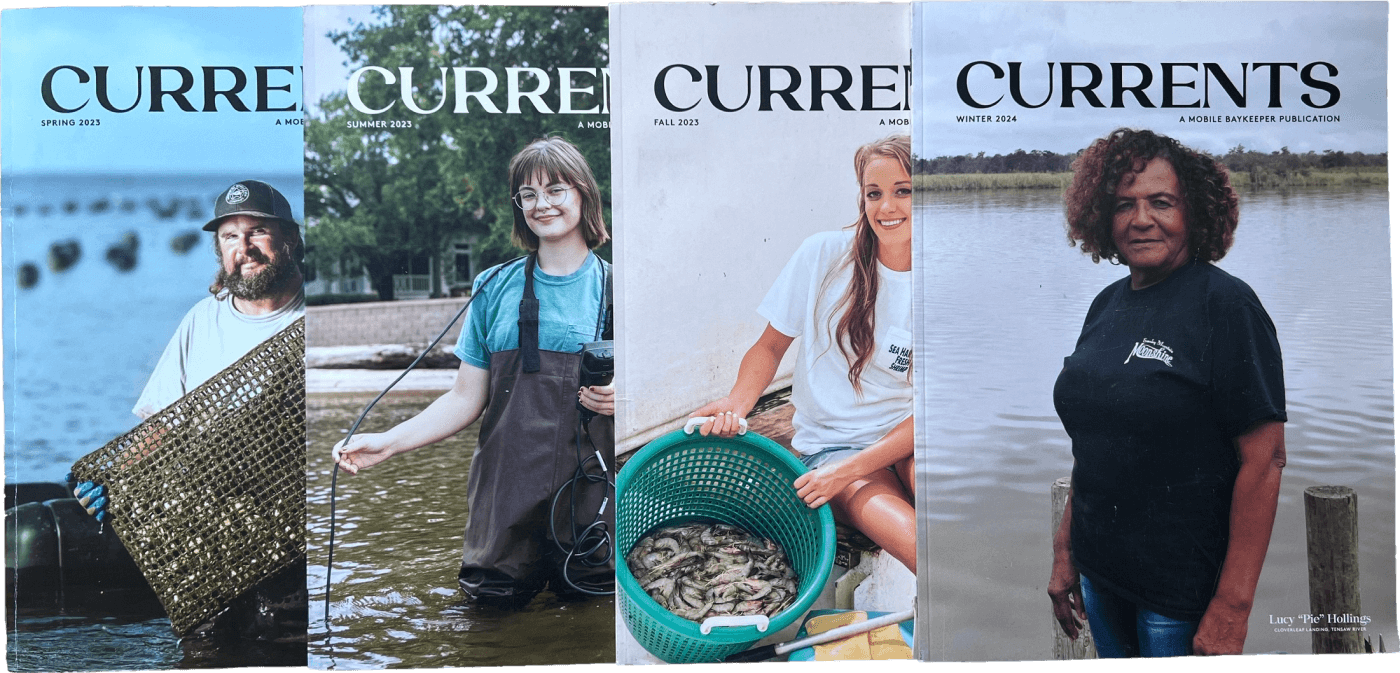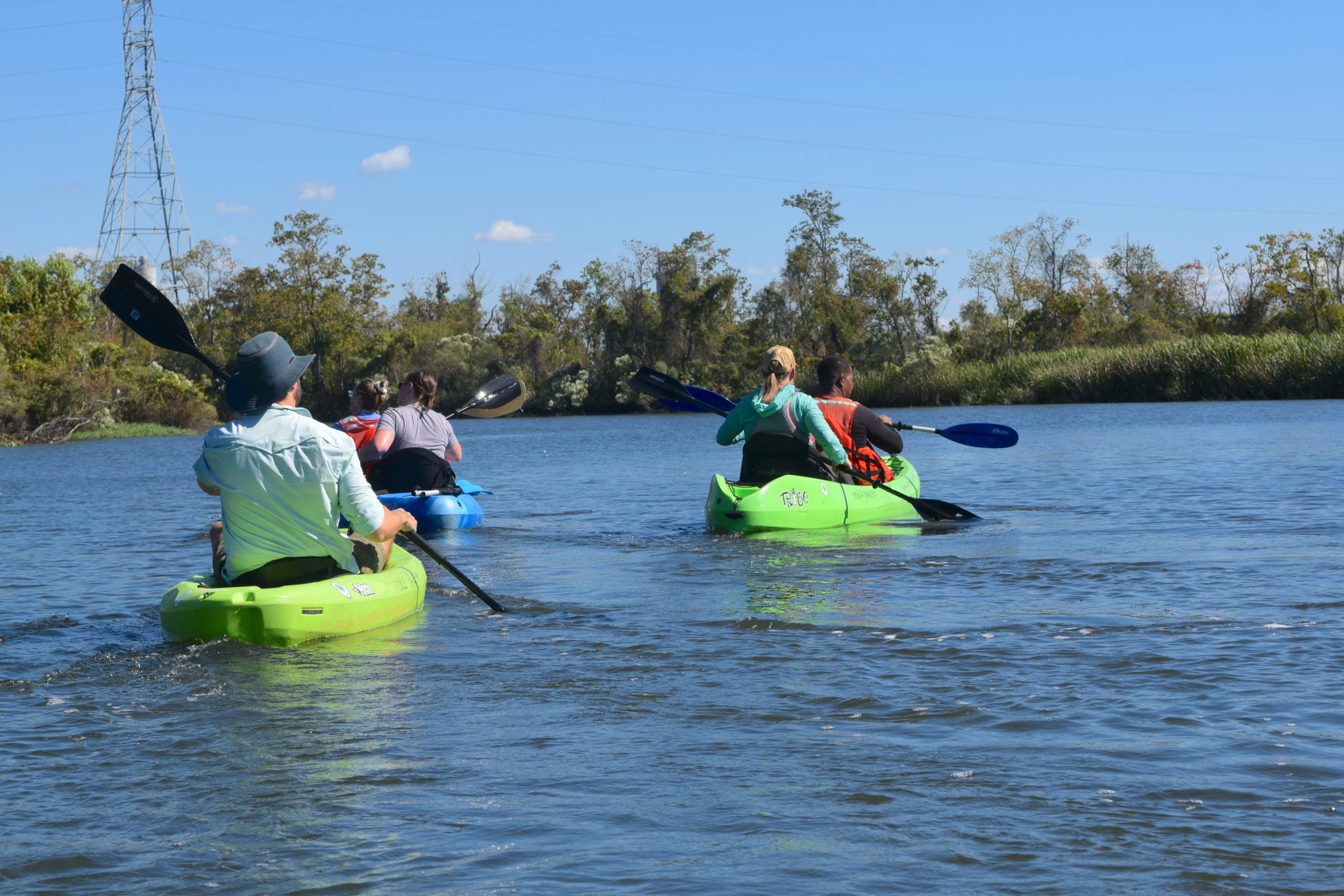
This article is from the winter edition of Mobile Baykeeper’s print quarterly, CURRENTS. The magazine is mailed to active members who have given more than $50 in the past year. To get on the magazine’s mailing list, donate here.
by Sam Wilkes | Photos and Video by Caine O’Rear
Years before the international media turned its spotlight on the Clotilda search, Africatown’s leaders had a vision aimed at reconnecting their community to the water. “Life is connected to water. Without water we cannot survive. The water brought us here,” says Leavie King, current Chairman of the Africatown Heritage Preservation Foundation (AHPF). “And once established here, the original residents understood how crucial the waterway was to their survival.”
Africatown’s exceptional history has largely been ignored in school curriculums and the national media until recently. Now there is a renewed interest, both locally and internationally, drawn from the discovery of the Clotilda wreck, the posthumous publication of Zora Neale Hurston’s Barracoon, and Margaret Brown’s award-winning documentary, Descendant. And with this attention comes the opportunity for healing and growth.
Connecting the Past
In early 1860, Kossola (later known as “Cudjo Lewis”), his brother Oluale (“Charlie Lewis”), and their fellow Yoruba people in the Bante region of current-day Benin, were ambushed by Dahomean women warriors in the predawn hours. Those too old or too young were beheaded, while the able-aged teens and young adults were stripped of their clothes and imprisoned in a barracoon (a barracks for enslaved peoples) within the slaving port of Ouidah.
Weeks later, they were sold to William Foster, captain of the Clotilda. Kossola (“Cudjo Lewis”), Oluale (“Charlie Lewis”), Abile (“Celia Lewis”), Abache (“Clara Turn- er”), Pollee, Rose, Monabee (“Katie Cooper”), Ossa Keeby, Anna Keeby, Josaphina Lee, Gumpa (“Peter Lee”), Zuma (“Zuma Livingston”) and 98 other enslaved Africans spent approximately 45 days aboard the infamous schooner, crossing an ocean they had never encountered, listening for the rhythm of the ship’s bell to prepare for the coming waves.

After entering Mobile Bay in July of 1860, the Africans were illegally sold into slavery under the cover of night. The Clotilda was the last slave ship to enter the United States, commissioned on a bet by wealthy Mobilian Timothy Meaher decades after President Jefferson had signed the “Act Prohibiting the Importation of Slaves of 1807.” Some of the Africans worked for the Meaher family on nearby plantations, while some labored aboard steamships, navigating bales up and down the Alabama rivers as a lifeline for the cotton kingdom.
Upon the war ending in 1865, many left their plantations and returned to the Mobile River, some camping for the first few weeks along the bank where the Africatown bridge crosses today. They wanted to return to their homeland but soon realized it was a near impossibility. They sought reparations from the Meahers but were ridiculed by them at the perceived audacity of the request. Most took jobs working for meager day wages, while others sold their handmade items, but they all agreed to pool their resources together to purchase their own land.
The area where most had settled belonged to the Meaher family, just north of Mobile from Three Mile Creek to Chickasabogue, with the gentle slopes of Plateau and Magazine Point flattening out into the surrounding waterways. It was a secluded area full of wildlife and plants that aided in survival. Between 1866 and 1868, they purchased the land from the Meahers and started their own settlement — Africa Town.
“With Africatown being situated right there on the water, it just breathed life into that community,” says Leavie King. The Africans built a community based on Yoruba customs and traditions, outside of any American governmental framework, and maintained their independence for many years. They dug out canoes from trees like they had learned back home. They caught trout, mullet, bream, and redfish by walking less than a mile to Three Mile Creek or the Mobile River. They hunted hogs and deer in the swamps of Hog Bayou. With the later adoption of Christianity, the local community churches used a portion of Three Mile Creek for their baptism rituals.
In the mid-1900s, the population that had started with about 30 people grew to nearly 12,000, with a flourishing commercial district of theaters, markets, barbershops, pharmacies, butchers, and a hotel. The community forged on, despite the consistent outside efforts to choke it out of existence. Most of the land surrounding Africatown has remained property of the Meaher family, which has been leased over the decades to a cadre of harmful neighbors, including an aluminum plant, Gulf Lumber, Kimberly-Clark, and one of the largest paper mills in the world, International Paper, among others. It is the epitome of environmental injustice.
Anderson Flen, a founding father of the AHPF, recalled: “Growing up in the 1950s and ’60s, we would walk to the water from my house and go crabbing under the [Africatown] bridge. And my father would try to catch every fish in the river, which created a challenge for my brother and I, as we had to sit out there and clean them all. Then you take some to your neighbor’s house because you couldn’t eat them all and had no way of storing them back then.”
Anderson graduated in 1968 from the Mobile County Training School in Africatown and has played a foundational role in all the current community organizations in Africatown. A warehouse now sits on the land where he was born. “We had become frustrated with how industry over time had blocked our access to the water in so many ways, transforming the land and making it terribly unhealthy,” Flen says. “We wanted an action plan with real tangible historical pieces so the City and State would understand the importance of the connection to the water.”
To the Present
This vision went into action around 2016, when the Alumni Association of the Mobile County Training School applied for technical assistance from the National Park Service (NPS) to help create a trail plan to make the waterways accessible to residents again. Liz Smith-Incer with the NPS provided her expertise on park trail routing and collaborated with Major Joe Womack, Anderson Flen, and other Africatown leaders regarding historical points of interest that needed to be exhibited.
The “Africatown Connections Blueway” offers more than ten miles of paddling and connects four jurisdictions (Mobile, Prichard, Chickasaw, and Mobile County) with three bodies of water (Three Mile Creek, the Mobile River, and Chickasaw Creek), ultimately linking the historic Africatown community with the promised Africatown U.S.A. State Park in Prichard. There are 14 points of interest designated along the Blueway. Africatown’s C.H.E.S.S. organization (Clean. Healthy. Educated. Safe. Sustainable.), led by director Major Joe Womack, has developed a trail map and booklet showcasing the points of interest. Some of the Blueway points include the following:
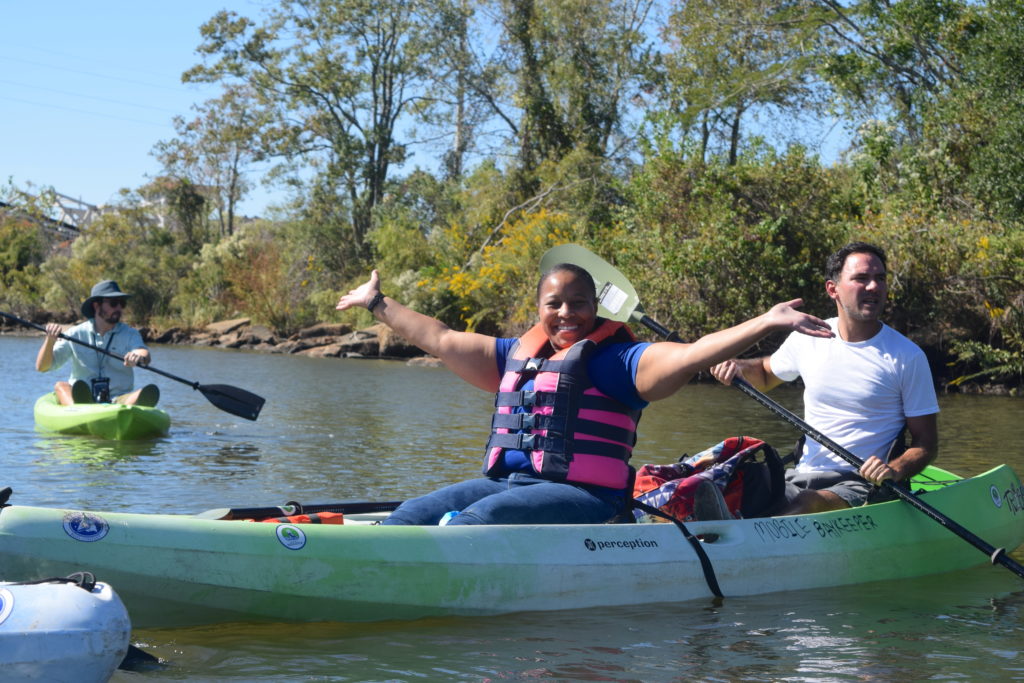
Lewis Landing One and Two: The eastern and western banks of Three Mile Creek located at Conception Street are known as Lewis Landing. Charlie Lewis was the older brother of Cudjo. Charlie ultimately married Maggie Lewis, a fellow captive on the Clotilda. Charlie was one of the founders of Africatown and the Union Missionary Baptist Church.
“They called Charlie ‘Papa’ as he was in his 30s when he first arrived here,” Joycelyn Davis, a direct descendant of Charlie, tells the website Our Southern Souls. “He was a skilled laborer and a fisherman.” Around 1880, he moved his family away from the original Africatown settlement. They followed Three Mile Creek in a westward direction, finding the area teeming with fish and wild game. He purchased the land from his former master, Col. Thomas Buford, and settled in the area later called “Lewis Quarters,” currently located near the intersection of Conception Street and Three Mile Creek.
A paddle along Three Mile Creek reveals the natural beauty that exists mere steps away from the asphalt grid. Industrial plants claim several waterfront lots but they don’t sully the whole experience. Egrets and ibises stalk the goldenrod-covered shorelines, while brown pelicans dive-bomb the surface of water. Cliff swallows fly from their mud-caked nests underneath the U.S. Highway 43 bridge. Old pilings reclaimed by time and foliage stand resolute in the shallows, as the nearby Mobile skyline presides over the horizon.
“A marker honoring the lives of the Africans and their descendants has been provided through AHPF’s partnership with UNESCO and it will be installed at this site,” says Anderson Flen. Lewis Landing One is property owned by the County of Mobile, while Lewis Landing Two is owned by the State of Alabama. In July of 2023, Governor Ivey announced that $1.5 million of Gulf of Mexico Energy Security Act funds would be allocated to Mobile County for developing the public access points at Lewis Landing, providing key points of interest along the Blueway.
“This is really exciting because that will give us a footprint as a part of our goal with the Blueway. It’s very important to see these projects that we had identified as a source or place of remembrance come alive in a very tangible way,” says Flen.
Africatown Baptism Landmark: The kidnapped Africans carried with them their culture and traditions across the Middle Passage. According to Yoruba tradition, ashe is the life-force of the universe, running through all living and inanimate things much like water. “Water plays an essential role in African culture,” says Ephrem Kioyi, a Benin-born U.S. immigrant. “I remember growing up in a small town in Benin, when the then-President of the Republic visited our town for the first time. My sister, Viviane, had the honor of pouring water at his feet on the grounds of the airport right before offering him Yellow Allamanda, the national flower of the country. I asked my mother the reasons for the rituals, and she answered that the water was to signify peace and the flowers, joy. This ritual was a symbol of the serenity that waterways provide to us.”
Anderson Flen notes another connection: “We take for granted that somehow we can survive in a world when the planet is over 70 percent water, there’s a reason — that wasn’t an accident — and you look at the human body which is over 60 percent water. So, we have to understand that water is critical and how that water is treated is critical.”
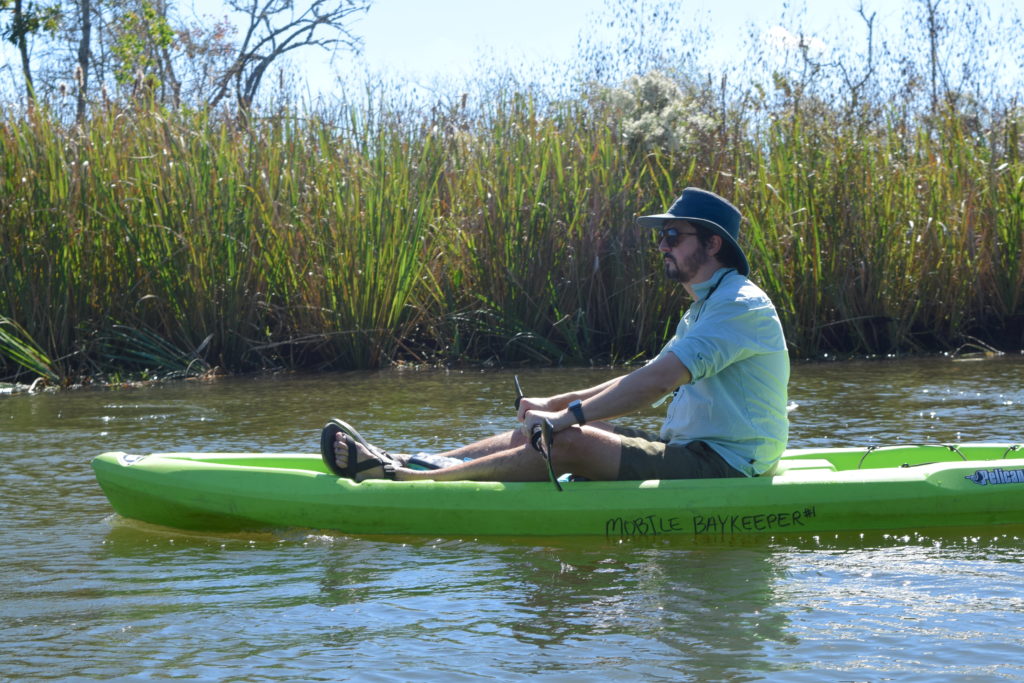
Through the years, some of the settlers of Africatown adopted American Christian customs and beliefs, including the sacred ritual of baptism. The Union Baptist Church was organized in 1869 as the Old Landmark Baptist Church by Reverand Henry McCrea and several Clotilda survivors. Later the local churches of Union Baptist, Green Grove Missionary Baptist, Yorktown Missionary Baptist, and Hopewell Missionary Baptist all shared the natural area south of the Magazine Point neighborhood on the northern banks of Three Mile Creek for their baptism rituals.
According to the Blueway informational booklet, the vision for this landmark is to “foster clarity, compassion, humbleness, forgiveness, love and inner peace” and “offer spaces to reflect and renew.” Plans exist for a boardwalk that leads to a circular viewing platform over Three Mile Creek with an art installation in the middle facing east toward Africa. The art installation may be viewed from the water or by the walking trail connected from the parking area off Chin Street. At the entrance of the walking path will be an art installation featuring 110 sentinels standing as one community.
Clotilda Landing: Located on the Mobile River underneath the Africatown Bridge, this point of interest is the location many returned to after regaining their freedom upon emancipation. Over the years, it is a point that has been used by locals for fishing, crabbing, as well as community gatherings and international celebrations. One such celebration was the “Merging of the Waters” in which young and old participated in having the water from the four different Blueway jurisdictions poured into one vessel to show a shared connection to the water and natural surroundings.
“We had hoped for an interpretative center located at the Clotilda Landing spot,” says Anderson Flen. “We were talking with the State and others about that, but then COVID interrupted those communications and they stopped.” It now seems as though plans may be reallocated to the Lewis Landing point of interest with the recent allocation of additional state funding.
Notwithstanding, extensive concept plans have been created by the Department of Landscape Architecture at Mississippi State University for a transportation transfer area, recreation area, and healing shoreline. “The students created renderings for the points of interest. Just masterpieces of work,” says Flen.
Railroad Turnbridge: This point of interest is considered the key to the doorway of Africatown’s waterway experience. Located on the western shore of the Mobile River and at the entrance of Chickasaw Creek, this railroad turnbridge is considered one of the oldest remaining turnbridges in America. The Africatown locals say that once one enters this turnbridge, they are entering the essence of Africatown.
Hog Bayou: This point of interest highlights the key hunting and fishing area for the original settlers and Africatown community. The settlers agreed to never build houses in the Hog Bayou area, so critical was the land to their initial survival. This tradition continued through the decades. “It was full of game. You could literally walk across the street, kill a hog, kill a deer,” Major Joe Womack, who hunted and fished the bayou with his grandfather, tells Ben Raines in his book, The Last Slave Ship. “We’d take a washtub, catch a mess of crabs, and take ‘em home to Momma. She’d make crab gumbo. If we weren’t playing sports, we’d be out there fishing and crabbing.”
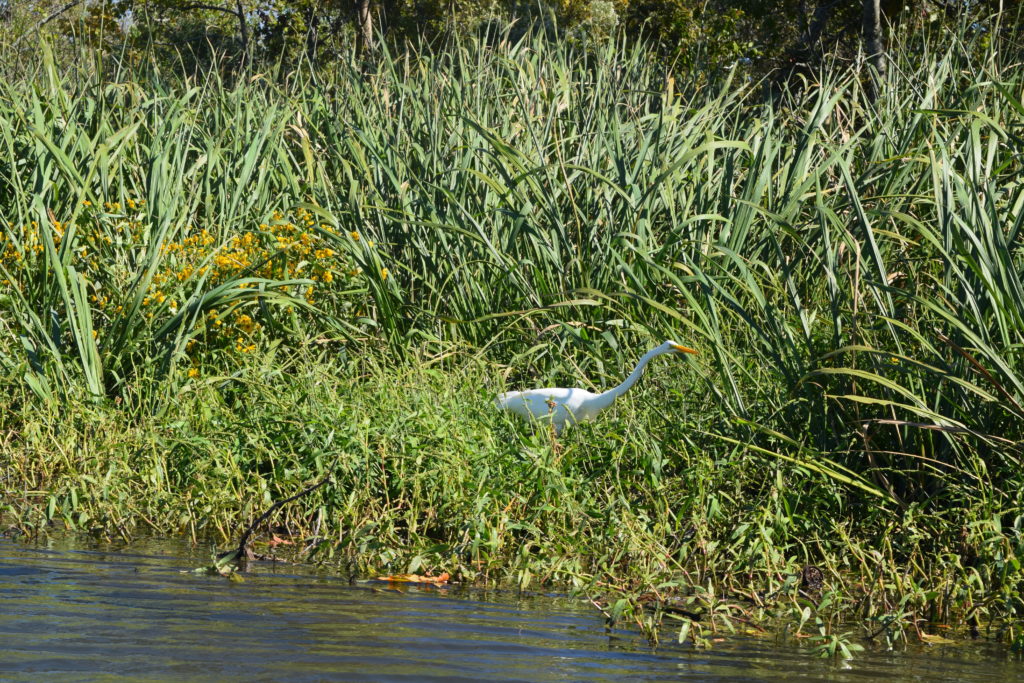
Hog Bayou was one of the only walkable access points Africatown residents had to the Mobile-Tensaw Delta, dubbed “American’s Amazon.” It is the nation’s second largest river delta with more species of fish, turtles, snails, salamanders, crawfish, and mussels than any other river system in America. Unfortunately, over the years, both International Paper and Scott Paper have built their facilities along the shores of Hog Bayou, impeding many residents’ access to the waterway.
Although Scott Paper is no longer operating, much of the area is now occupied by Borusan Berg Pipe. The community is working with the EPA and other organizations for testing and clean-up work. (See “Reclaiming Africatown’s Hog Bayou” by Emmie Fontenot in the Fall 2023 edition of CURRENTS.) Therefore, reclaiming this unique entry point is critical to creating greater recreational opportunities for the surrounding communities.
Other points of interest along the Blueway as one paddles up Chickasaw Creek include the Historical Chickasaw Docks, William Brooks Park, Off the Hook Marina & Grill, Chickasabogue Park, the white sand beaches of the Shelton Beach Road Access, University of Mobile Paddle Launch, and the Highway 158 Paddle Launch.
Africatown Connections Blueway is a part of the Mobile County Blueway system. The county is committed to funding three of the Blueway’s points of interest: Chickasabogue Park, Lewis Landing, and Shelton Beach Road. The county is currently upgrading the infrastructure at Chickasabogue Park, as well as building an events and interpretive center, playground and splash-pad area, RV campground, boat ramp, additional disc golf holes, and new restroom facilities. The route will culminate at a large parcel of undeveloped land, designated by the State of Alabama for future development of the Africatown USA State Park. Concept plans have been designed by Auburn University and include a living-history African village concept.
“It’s all about the healing process,” says AHPF Chairman Leavie King. “And healing comes from being appreciated, showing value, showing value proposition for the future, and showing economic growth and impact that can be made directly to the community by the Blueway. We want the community to understand how they can benefit from the Blueway, how they can appreciate the history and how their ancestors valued the waterways there, and how it connected all of the people up and down.”
Local resident Charlie Jones admitted he was skeptical before he paddled a portion of the Blueway from Lewis Landing to the Baptismal spot. “Having something like the Blueway, now it changed my mind just going out there in the kayak for the first time. I think more children, and more people from Africatown, should come out and experience it,” he says. “What you’re doing with the Blueway — it’s giving people access. A means to come out and enjoy. The business community and everybody has got to come together. Whatever we’re doing with the Blueway, having kayaks available so people can come here and take advantage of this — it’s the right thing.”
While creating infrastructure to support increased access to the Blueway is underway, locals and visitors alike have the opportunity to get out on the waterways and explore the Africatown Connections Blueway now. Out of the Blueway’s 14 points of interest, there are already some current access points to launch a canoe or kayak from, including Off the Hook Marina, William Brooks Park, Clotilda Landing, and Lewis Landing 1. Both Lewis Landing 1 and the Clotilda Landing (underneath the Africatown bridge) don’t have configured launch ramps or docks, but a canoe or kayak may be launched from the shore. Additionally, local outfitting companies WildNative Tours and Mobile Kayak Rental Company have boats available for rental.
For the Future
The Africatown leaders are aiming for a revision of mindsets and generational change. To meet that vision, they have developed another program that is interconnected with the Blueway — the Africatown Swim Program. The Blueway trail has opened “outlets for youth to experience water sports in meaningful ways, but many fear the water for lack of experience … Africatown, like many minority communities, has an alarming number of youth that cannot swim due to a number of complex issues,” states Curtis Flakes (retired Executive with the U.S. Army Corps of Engineers, Planning and Environmental Division, and current head of the Swim Program) in a written summary about the program.
In early 2023, Anderson Flen set out to re-establish a swim program for the community. With the help of the Mobile Parks and Recreation Department and other qualified individuals in the area, the program announced free swim lessons to the underserved community, along with transportation and snacks. The Program received more than 200 applicants but could only accommodate about 120 students.
“We shocked ourselves,” says Leavie King. “We wanted to make that impact to make sure our youth are able to survive. The mortality rates of African American youth surrounding the water are just horrible. We thought a swim program would be a great segue with the Blueway, to continue to keep the enjoyment of the waterways and remove that fear and apprehension.”
The lessons began in June of 2023 and the program graduated 123 students in August of 2023. “None of them knew how to swim but they all graduated as swimmers,” says King. “A huge cultural win and impact that affects generations. This will be one of our staple programs each year and keep those kids connected to the water.”
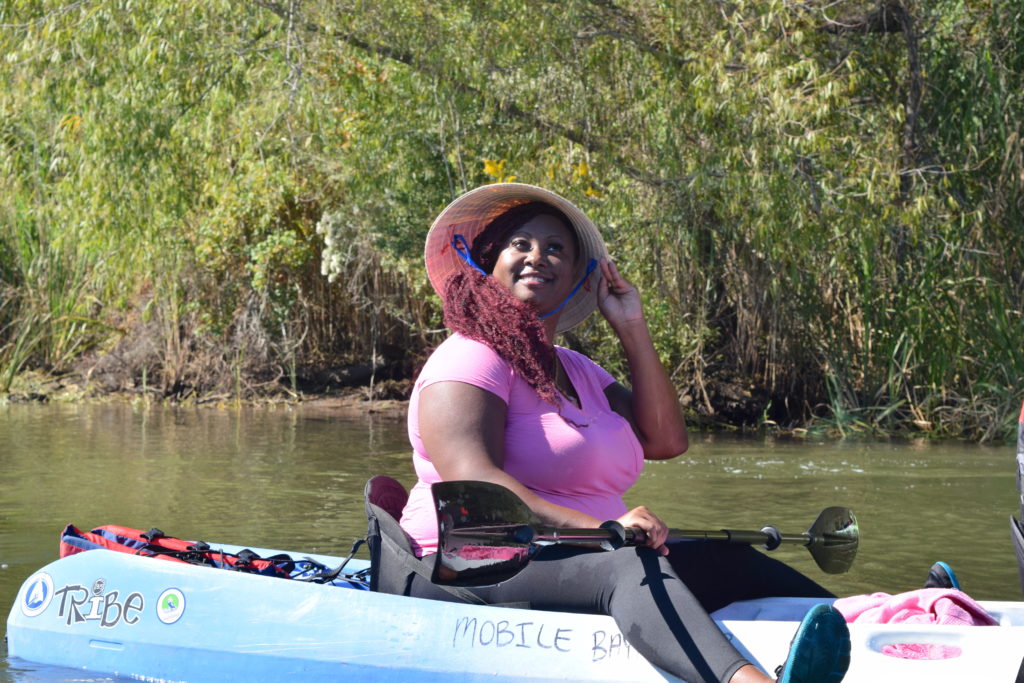
Building on the vision, the Swim Program has now partnered with the internationally recognized Diving with a Purpose to offer scuba lessons. As Mr. Flakes states, “It is the AHPF’s intent that these and other swimmers in the Mobile area use this platform to become certified scuba divers and perhaps one day join the underwater research effort related to the Clotilda.”
It’s easy for one to see how it’s all interconnected by bringing the community back to the water and to its history. “The Blueway will always be special because it was our first,” says King. “But it also gave us the confidence and energy to develop even more initiatives under the Foundation. Just to show that we are living up to our mission and vision.”
This past Juneteenth, Birmingham urban designer Renee Kemp-Rotan, and Vickii Howell, CEO of M.O.V.E. Gulf Coast CDC, announced the winners of the Africatown International Design Idea Competition. The winners came from as far away as South Africa, Jamaica, and China, as well as from New York, D.C., and Nashville. The competition prescribed four sites for design — Historic Africatown, Josephine Allen public housing area, the Africatown USA State Park, and the Africatown Connections Blueway. The applicants submitted design concepts for each point of interest along the Blueway — from inventive pavilions and boardwalks over the water to distinct boat fleets.
“The passion and detail put in these ideas will really make the community proud. But it will ultimately be up to the community and the AHPF how they may want to use these designs,” says Vickii Howell. “And we will always have the collection of these designs.
So that if and when the community decides to hire one of these designers or implement the concept, we’ve created an opportunity not only for the community but also for these designers, cause most of them are African-American, too. Eco-tourism is a huge industry, and these things present opportunities for the community, not only to share their story, but also create economic opportunities. We have so many assets here in Mobile. And it wasn’t really until I got back home that I realized we are really a water city. Yet we don’t really take advantage as much as we need to of the ecological strength of our area.”
Recently, the City of Mobile, with the aid of an EPA grant, requested a brownfield assessment on six unused plots of land in Africatown to determine if they were contaminated. The answer arrived in October of 2023 resulting in four of the six sites being safe and usable. For two sites, Lewis Landing and Josephine Allen, “there’s contamination present, but it’s easily remediated,” Mobile’s environmental manager, Ray Richardson, tells NBC15 News.
Anderson Flen sums it up when he says, “When you get out of balance with nature, nature punishes you for that. We have to clean up our homes and respect our homes. They will keep us healthy, or we will make ourselves sick. Because they are not going to make us sick. We do that to ourselves. So, we have a responsibility to keep them as healthy as possible.”
The same brownfield assessment grant has already resulted in the revival of other sites in Mobile. Once remediated, the “brownfield sites can become just about anything imaginable,” says Richardson.
With the State allocating $1.5 million for Lewis Landing and the brownfield assessment grant, the AHPF leaders feel the momentum is swinging in their favor and it’s time to harness that energy. “We have community actors moving to assist us with making these build-outs for the Blueway,” says King. “We want to bring small business back to the community. Bring in local tour guides and train them on how to lead a tour through the Blueway as it connects to Africatown. The State is also extremely vested in the success and expansion of Africatown and the Blueway. We have the capacity to develop off the same blueprint as Montgomery’s National Memorial, but even larger with international pull, if we do it the right way. The State has witnessed that and they understand.”
There is still plenty of work to be done, some of which will require citizen action with modifying outdated zoning laws and holding polluters accountable, but it’s evident the vision is being realized in tangible ways and the seeds are being planted for posterity. With his timeless wisdom, Anderson Flen observes: “If Mobile is going to reach its full potential, it’s going to need people with vision to understand that the environment is really its strongest asset. And it has been disrespected for so many years for so long, it’s going to have to change. The environment will heal itself. I may not be here to see it. But I can leave plans here for people to see we had the vision, and when it starts healing itself, they can take those plans and make Mobile what it should be, in terms of working with nature as opposed to trying to dominate it.”
Sam Wilkes is an attorney, musician, and writer. A native of Opelika, Alabama, he now resides in Fairhope with his family. He serves on Mobile Baykeeper’s Board of Directors.
